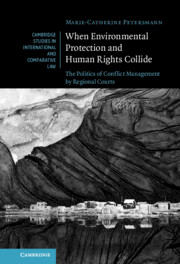 When Environmental Protection and Human Rights Collide
When Environmental Protection and Human Rights Collide Book contents
- When Environmental Protection and Human Rights Collide
- Cambridge Studies in International and Comparative Law 172
- When Environmental Protection and Human Rights Collide
- Copyright page
- Contents
- Acknowledgements
- Table of Cases
- Introduction
- Part I Constructing Synergies: Framing the Environment–Human Rights Interface
- 1 Narratives of Environmental and Human Rights Protection
- 2 Horizons of Synergy
- 3 Constructing and Contesting Anthropocentric Synergies
- 4 Countering the Dominant Frame
- Part II Conflict Mediation through Universalisation
- Conclusion
- Bibliography
- Index
- Cambridge Studies in International and Comparative Law
2 - Horizons of Synergy
Adjudicating Environmental and Human Rights Protection
from Part I - Constructing Synergies: Framing the Environment–Human Rights Interface
Published online by Cambridge University Press: 20 October 2022
- When Environmental Protection and Human Rights Collide
- Cambridge Studies in International and Comparative Law 172
- When Environmental Protection and Human Rights Collide
- Copyright page
- Contents
- Acknowledgements
- Table of Cases
- Introduction
- Part I Constructing Synergies: Framing the Environment–Human Rights Interface
- 1 Narratives of Environmental and Human Rights Protection
- 2 Horizons of Synergy
- 3 Constructing and Contesting Anthropocentric Synergies
- 4 Countering the Dominant Frame
- Part II Conflict Mediation through Universalisation
- Conclusion
- Bibliography
- Index
- Cambridge Studies in International and Comparative Law
Summary
This chapter provides an overview of key judgments by international courts and tribunals dealing with environmental and human rights protection. It focuses mainly on regional human rights courts to show how environmental protection has been dealt with under these mechanisms. The objective is not to offer a comprehensive analysis of the environmental jurisprudence of these judicial mechanisms, but to signal how a specific synergistic and anthropocentric framing of environmental protection emerged in catalytic judgments. A particular narrative of how the protection of the environment would benefit human rights – especially the right to health, to life and to adequate living conditions or family life, as well as the right to private property and the right to (ancestral) land – was produced and consistently re-affirmed through judicial cross-referencing. This was done by pointing out how environmental harms and ecological deterioration and pollution directly hamper human rights, including those of indigenous peoples and cultural minorities. In so doing, courts played a pivotal role in strengthening environmental protection in relation to human concerns, thereby also consolidating a particular representation of how a protected environment serves human interests and needs. A specific anthropocentric and synergistic understanding of the human–environment is thereby enacted and reenforced.
Keywords
- Type
- Chapter
- Information
- When Environmental Protection and Human Rights CollideThe Politics of Conflict Management by Regional Courts, pp. 56 - 79Publisher: Cambridge University PressPrint publication year: 2022
